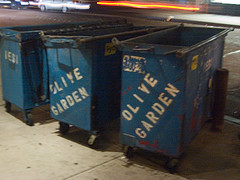Are These The Final Days Of Automatic 18% Tips At Restaurants?

(Eva_Deht)
The change, which goes into effect in January, reclassifies automatic gratuities as service charges rather than standard tips. To the consumer, this doesn’t mean anything, but to the restaurant and the wait staff, it could be a big headache.
Currently, when the restaurant adds $45 to your group’s $250 bill, that amount is still considered a tip. The servers get all of that money and are responsible for paying tax on it themselves.
But when that gratuity suddenly gets reclassified as a “service charge,” the money is now treated like regular wages, which means the restaurant owner has to withhold payroll tax.
For the server, it means they initially receive less money in their pockets and don’t have as much wiggle room when it comes time to file their taxes (because, let’s admit it, not every restaurant server is reporting every dollar received in tips). This is especially true for servers who work at eateries popular with after-work crowds that often handle big groups.
Restaurant management, meanwhile, must now deal with an added headache of sorting out service charge money from tip money and knowing which to withhold taxes from. As things are now, the restaurant pays a base wage (usually below the federal minimum wage level) and lets the servers keep whatever tips they receive. But after the new rule goes into effect, that automatic tip money has to be figured as part of a server’s hourly wages.
For example. Waiter Steve makes $3.00/hour plus tips. For a 40-hour week, that’s $120 plus tips. So long as his tips bring him up to the minimum wage level, the restaurant doesn’t need to pay him anything else and only figures payroll tax based on the hourly wage.
Right now, Steve averages three large tables a week where the automatic gratuity averages $70/table. That $210 goes into his pocket and he pays taxes to the IRS and state himself.
After the new rule kicks in, that $210 is no longer considered a tip but is now deemed to be part of Steve’s wages, more than doubling the base pay the restaurant had been figuring previously. And what happens when there’s a dry spell and those big tables dwindle down to only one per week? Now the restaurant is figuring yet another hourly wage for Steve.
Darden Restaurants, better known as the parent company of Olive Garden, Red Lobster, LongHorn Steakhouse, normally adds an 18% automatic gratuity for parties of 8 or more, but recently dropped that policy at restaurants in four cities in advance of the IRS rule change, and to test a new system that calculates and suggests tip amounts of 15%, 18%, and 20% for groups of all sizes.
Likewise, the folks at Texas Roadhouse are getting rid of their 15% auto-tip for parties of 8 or more.
“I don’t want my tips to be on my paycheck as a wage. I like to get my tips at the end of my shift because I know what I’m getting right away,” one server at the restaurant chain tells the Wall Street Journal.
The IRS updated the rule because it maintains that a mandatory gratuity is not actually a tip if it’s not voluntary.
“I think the vast majority of restaurant owners will discontinue the practice,” an employment attorney specializing in the restaurant business explains to the Journal.
A small number of upscale restaurants have recently switched from tips to adding mandatory service charges to all bills, while even fewer eateries have done away with tipping and service charges altogether and simply built the extra costs into the prices on the menu.
Earlier this week, NY Times restaurant critic Pete Wells wrote that it’s time to do away with the institution of tipping, which he dubbed “irrational, outdated, ineffective, confusing, prone to abuse and sometimes discriminatory.”
IRS Rule Leads Restaurants to Rethink Automatic Tips [WSJ.com]
Want more consumer news? Visit our parent organization, Consumer Reports, for the latest on scams, recalls, and other consumer issues.

